先决条件: 线性回归
线性回归是一种基于监督学习的机器学习算法。它执行回归任务。回归基于自变量对目标预测值建模。它主要用于找出变量和预测之间的关系。不同的回归模型基于–正在考虑的因变量和自变量之间的关系类型以及所使用的自变量数量而有所不同。
本文将演示如何使用各种Python库在给定的数据集上实现线性回归。我们将演示一个二进制线性模型, 因为这将更易于可视化。
在此演示中, 模型将使用”梯度下降”进行学习。你可以了解一下这里。
步骤1:导入所有必需的库
import numpy as np
import pandas as pd
import seaborn as sns
import matplotlib.pyplot as plt
from sklearn import preprocessing, svm
from sklearn.model_selection import train_test_split
from sklearn.linear_model import LinearRegression步骤2:读取资料集
你可以下载数据集这里。
cd C:\Users\Dev\Desktop\Kaggle\Salinity
# Changing the file read location to the location of the dataset
df = pd.read_csv( 'bottle.csv' )
df_binary = df[[ 'Salnty' , 'T_degC' ]]
# Taking only the selected two attributes from the dataset
df_binary.columns = [ 'Sal' , 'Temp' ]
# Renaming the columns for easier writing of the code
df_binary.head()
# Displaying only the 1st rows along with the column names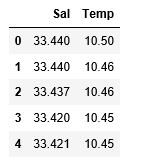
步骤3:探索数据分散
sns.lmplot(x = "Sal" , y = "Temp" , data = df_binary, order = 2 , ci = None )
# Plotting the data scatter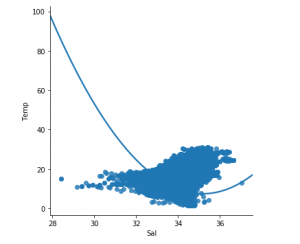
步骤4:资料清理
# Eliminating NaN or missing input numbers
df_binary.fillna(method = 'ffill' , inplace = True )步骤5:训练模型
X = np.array(df_binary[ 'Sal' ]).reshape( - 1 , 1 )
y = np.array(df_binary[ 'Temp' ]).reshape( - 1 , 1 )
# Separating the data into independent and dependent variables
# Converting each dataframe into a numpy array
# since each dataframe contains only one column
df_binary.dropna(inplace = True )
# Dropping any rows with Nan values
X_train, X_test, y_train, y_test = train_test_split(X, y, test_size = 0.25 )
# Splitting the data into training and testing data
regr = LinearRegression()
regr.fit(X_train, y_train)
print (regr.score(X_test, y_test))
步骤6:探索我们的结果
y_pred = regr.predict(X_test)
plt.scatter(X_test, y_test, color = 'b' )
plt.plot(X_test, y_pred, color = 'k' )
plt.show()
# Data scatter of predicted values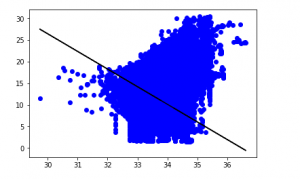
我们模型的低准确性分数表明我们的回归模型与现有数据不太吻合。这表明我们的数据不适合线性回归。但是有时候, 如果我们仅考虑一部分数据集, 则它可能会接受线性回归。让我们检查这种可能性。
步骤7:使用较小的数据集
df_binary500 = df_binary[:][: 500 ]
# Selecting the 1st 500 rows of the data
sns.lmplot(x = "Sal" , y = "Temp" , data = df_binary500, order = 2 , ci = None )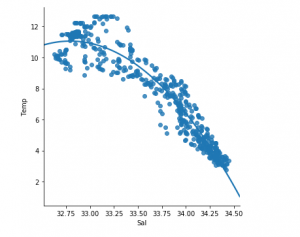
我们已经可以看到前500行遵循线性模型。继续执行与之前相同的步骤。
df_binary500.fillna(method = 'ffill' , inplace = True )
X = np.array(df_binary500[ 'Sal' ]).reshape( - 1 , 1 )
y = np.array(df_binary500[ 'Temp' ]).reshape( - 1 , 1 )
df_binary500.dropna(inplace = True )
X_train, X_test, y_train, y_test = train_test_split(X, y, test_size = 0.25 )
regr = LinearRegression()
regr.fit(X_train, y_train)
print (regr.score(X_test, y_test))
y_pred = regr.predict(X_test)
plt.scatter(X_test, y_test, color = 'b' )
plt.plot(X_test, y_pred, color = 'k' )
plt.show()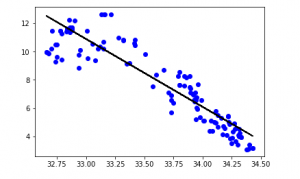
首先, 你的面试准备可通过以下方式增强你的数据结构概念:Python DS课程。
 srcmini
srcmini
评论前必须登录!
注册